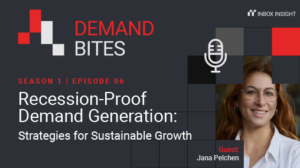Today’s B2B demand generation managers often find themselves under pressure to do more with less. As marketing budgets tighten and audience expectations keep changing, the need for scalable content strategies is more crucial than ever.
In this context, a well-structured repurposing workflow can really make the difference. It allows brands to make the most of their resources, amplify their messaging, and create fresh content for a variety of channels and touchpoints.
What is content repurposing?
Content repurposing is all about taking your existing assets and turning them into different formats to increase their mileage.
This approach not only prolongs the lifespan of these assets, but can also support multi-channel marketing efforts. By adapting your content for various platforms, you can create personalized, high-performing assets tailored to different stages of the buyer journey.
For example, a detailed whitepaper could be broken down into a series of blog posts, infographics, or social media snippets, each crafted to meet a specific audience’s needs and preferences.
Why implement a content repurposing workflow?
Implementing a content repurposing workflow brings numerous advantages, particularly in enhancing efficiency and maximizing resource utilization.
Boosting content production efficiency
One significant benefit of content repurposing is the ability to produce more content without proportionally increasing costs. By reusing and adapting existing materials, companies can maintain a steady flow of content while staying within budget limits.
Expanding reach and engagement
Repurposing content allows businesses to effectively target diverse decision-makers within B2B accounts. By tailoring content to different segments, organizations can enhance both their reach and engagement, while ensuring that each piece of repurposed content speaks directly to its intended audience.
Supports scalable lead generation and nurturing
Scaling lead generation and nurturing efforts is crucial for sustained growth and success. Content repurposing workflows allow marketers to create a steady stream of valuable content that can be leveraged across multiple channels and touchpoints. This enables demand generation managers to scale their campaigns without investing significant time and resources into new assets.
Improving key metrics
A structured content repurposing workflow can significantly improve key performance metrics. Tailored content enhances lead quality by addressing the specific needs and pain points of prospects, leading to higher conversion rates. Additionally, repurposed content often achieves increased engagement rates as it is optimized for the platforms and audiences where it is most effective.
How to identify which content to repurpose
Start by conducting a thorough audit of your content library to identify assets that might be suitable for repurposing. You may consider the following factors:
- Performance metrics: Focus on high-performing content, such as blog posts, webinars, or whitepapers with strong engagement rates, high traffic, or impressive conversion metrics. These assets have already proven their value and resonate well with your audience.
- Timeliness and relevance: Choose content that reflects current trends, addresses evolving audience needs, or ties into upcoming campaigns. Refreshing older but still relevant materials can save time while maintaining impact.
- Adaptability across formats: Prioritize assets that can be easily transformed into multiple formats. For example, a detailed guide could become a series of videos, an infographic, or social media snippets that can be used across a range of platforms and channels.
Steps to create an effective content repurposing workflow
Step 1: Define your goals
Before you start repurposing content, make sure you’ve set some clear goals. Maybe you want to back up your account-based marketing (ABM) campaigns, craft content specifically for decision-makers at different stages of the sales journey, or just keep your content campaigns relevant for longer. Having clear objectives will help guide your efforts and ensure everything lines up with your overall marketing strategy.
Step 2: Select anchor formats
Anchor formats are really important when it comes to repurposing content, and they’re a huge help for demand generation managers. Some formats are particularly effective: you can break down eBooks into a series of blog posts, turn webinars into short social media videos, or change case studies into eye-catching infographics for your sales team. These strategies help you connect with different audiences and make the most of various channels.
Step 3: Outline your process
Creating a clear roadmap is key when it comes to turning your core content into different formats. This plan should match up with your campaign goals and lay out each step in the repurposing process, helping you keep everything consistent and efficient.
Step 4: Tailor content for specific channels
Different channels have their own quirks and audience expectations, so it’s important to tailor your content to fit these specifics for better engagement and to avoid content fatigue.
Our research indicates that 84% of B2B decision-makers use social media for research, so it’s crucial to adapt your long-form content for these platforms to increase awareness. However, avoid using a one-size-fits-all approach—videos and visuals designed for LinkedIn should differ in style and tone from those intended for Instagram, for example.
Creating ads that are specific to each platform using repurposed visuals and messages also helps you connect with your audience and meet the standards of the platform. Plus, developing tailored content for email marketing nurture sequences can help keep leads engaged over time.
Step 5: Develop a scheduling plan
Timing is everything when it comes to content distribution. Creating a schedule that lines up with the different phases of your campaign and peaks in audience engagement ensures that your repurposed content hits at just the right moments. This strategic timing helps each piece of content make the biggest impact and supports your overall campaign goals.
Step 6: Analyze and measure performance
Measuring the success of repurposed content involves tracking various metrics. Key indicators include content performance by channel (such as click-through rates and lead conversions), return on investment (ROI) for repurposed content, and its contribution to ABM success and pipeline acceleration.
Regularly analyzing these metrics helps you fine-tune your repurposing process and improve future content strategies. Having strong tracking systems and clear attribution models is key to measuring the real impact of repurposed content and justifying it to stakeholders.
Leveraging automation in your content repurposing workflow
Automation tools can significantly streamline the content repurposing process.
Platforms that handle content scheduling, track engagement, and automate email workflows cut down on the manual work, freeing up your team to focus on bigger strategic tasks. Integrating these tools with your CRM and marketing automation platforms ensures seamless content distribution and keeps your messaging consistent across all channels.
The role of generative AI in content repurposing
Generative AI tools can play a pivotal role in streamlining content production and repurposing. These technologies can help generate drafts, rephrase content, or create variations tailored to different audiences.
The benefits of generative AI
- Cost-effective scalability: You can minimize your reliance on extensive human resources while achieving faster production timelines.
- Time savings: AI can accelerate your workflow, especially for repetitive or foundational tasks such as ideation and reformatting.
- Personalization at scale: AI tools can produce content variations that resonate with specific personas or buyer stages.
Addressing AI challenges
Using AI in these workflows comes with its own set of challenges. Ensuring the quality and brand alignment of AI-generated content often needs a human touch. You also need to consider ethical issues like copyright, misinformation, or bias in AI outputs to maintain trust and authenticity.
Final thoughts
A content repurposing workflow isn’t just about stretching budgets—it’s about unlocking the full potential of your existing assets to meet the demands of modern multi-channel marketing.
By combining automation, AI, and performance insights, demand generation managers can consistently deliver impactful content that drives engagement, scales lead generation, and fosters sustained growth.
Embracing repurposing ensures your strategy remains agile, efficient, and poised to adapt to ever-changing audience expectations.
Maximize your content’s potential
Turn one great piece of content into multiple high-performing assets. From guides and blog posts to infographics, we repurpose your content for maximum reach and impact. Let’s create something powerful—learn more about our content creation services.






